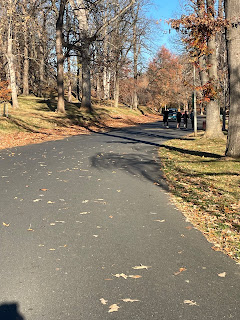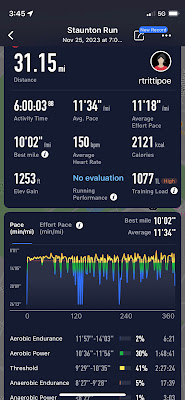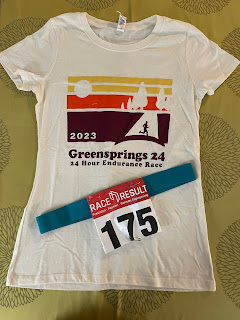In the aftermath of my third 24-hour race, I am recoiling a bit. The phrase, "There is dignity in completion," written by ultrarunning great and philosopher, Sabrina Little, is running a circuitous route through my gray matter. I am bothered by it--and somewhat embarrassed--that I stopped approximately two hours and five minutes short of the 24-hour mark. Why? Why did I decide to bag the effort with time remaining on the clock? It's complicated but at the same time quite simple.
Sabrina also put digital pen to paper to say
"Patience is the virtue of remaining in difficulty." If I understand that concept correctly, there is an embedded implication that not choosing to remain in the difficulty is a sign of impatience, a not-so-virtuous marker of sub-optimal character. So yikes. It's a little disconcerting to contemplate the extent of my failing. Here's the backstory.
With no pressure-producing cut-off designations, the timed races (eg. 24 hrs) hold a certain appeal as I get older and much, much slower. There is no possibility of being forced to stop at an aid station because of failure to arrive on time. And in fact, there is no expectation by race management of traversing an established number of miles. Rather, each runner gets to select their own pace and distance covered.
I went into this race with less than optimal training. In fact, I'm not sure my preparation (or lack thereof) even qualifies as training. The demands of my day job leave me chronically exhausted, spending 10-13 hours, sometimes more, seldom less, daily away from home. Understanding that lack of time is often an excuse, it is an unfortunate reality that impacts my desire and physical stamina.

Nonetheless, I was looking forward to a weekend away from my normal routine. I took a vacation day on either side of the weekend to revel in alone time. And of course, I would have plenty of solo time to reflect on significant (and not so significant) contemplations on Saturday and into Sunday as I circled the prescribed 2.25-mile loop over and over again.
By 8:00 AM Saturday I was on the way, along with 91 other participants in this inaugural event: the Greensprings 24 HR. Even with low miles coming into the race, the first several laps felt easy. It was rather surprising how quickly I was engulfed in a bubble of solitude, racers spreading out and friend groups chatting among themselves. I was content to be silent, gliding along smooth, wide trails dotted with planked footbridges constructed with seamless approaches and exits.
The day warmed quickly into the mid-80s. With the exception of the 200-yard approach to and from the electronic timing pad, the course meandered through the forest, the tree canopy allowing only dappled sunlight to reach my shoulders. Along one arm of the rectangular-ish, clockwise course, houses could be seen not far from the course. How lucky those homeowners were living so close to these well-maintained trails! Then it was a right turn onto a short stretch before another right turn onto more of the same: sweet, wide trail and planked footbridges across low laying areas, this stretch sans houses.
Once the trail hit a paved path, we took another turn to the right before merging onto a massive 20-foot wide elevated wooden bridge that disappeared around a corner some 400 yards ahead. We turned right again, before reaching the bridge's end. Now, a swamp appeared on either side, leading to another bridge, this one long, narrow, and winding. The runner was awarded with sweeping views of trees punctuating the surface, birds soaring overhead, and a cacophony of croaking and chirping. It was another right turn after the bridge and a mere football field length of trail before a turn to the left, climbing the only hill on the course, around a huge evergreen, and across the field to cross the timing mat.

As the day gave way to dusk, I was content to run some, walk some, counting steps to keep my mind occupied and feet moving. Two young women, always running side-by-side and looking effortless as they laughed their way down the trail, passed me like I was standing still. (In fact, they passed me ten times all together.) Nonetheless, they were kind and encouraging to this 66-year old runner, the three of us enjoying these brief but predictable interchanges. (For fear of a spoiler alert, they ended up with a little over 100 miles in the 24 hour period.)
As the clock struck midnight at the16-hour mark, smaller numbers of runners maintained their 2.25-mile trek. The race organization, in an effort to encourage participants of any experience level to tackle the course, had advertised special awards for significant milestones: 50 miles, 100K, 75 miles, and 100 miles. If the dwindling number of tents in the open field were any indication, more than a few runners chose to retire from their efforts, pleased with meeting personal goals.
Sometime in the wee hours, I found myself fighting the urge to close my eyes and give in to the serious head-bobbing and sleep-walking stagger. The remedy was to talk to God--out loud--about all sorts of things. Prayers of thanksgiving, protection and salvation for family and friends, and for wisdom and guidance escaped my lips and rose to the heavens. It was the personal revival I desperately needed.

Despite the uplift of spirit, my feet kept me grounded. I could feel significant blisters. But more than that, my orthopedically-impaired feet felt as though someone had taken a hammer to them. Additionally, the O'Dark 0400 hour brought on a disturbing sensation. A sharp, transient, but recurring twinge in my left chest ushered in some concern and prompted continued prayers for wisdom and good sense. Having heart disease, a stent for a partially occluded coronary artery, and an implanted loop recorder, there was reason to be suspect. The sharp pain was not new. I had felt it a few times in the last couple months. However, it was never really associated with other foreboding symptoms of shortness of breath, arm pain, and the proverbial elephant sitting on the chest. My theory was that the loop recorder implanted three years ago had migrated from its original position and was somehow responsible for what I was feeling. At least, that's where the pain seemed to be located. Still, I wasn't sure and didn't want to be stupid. It was a predicament that required deep thinking.

Unfortunately, the full moon that lit up the night failed to light up a clear solution as I continued my now long walk in the woods. Rather, I was conflicted, calculating the time of day and miles to go. I was over 50 miles and had eclipsed 100K as well. Should I stop now? No. I would continue. The least amount of miles I would accept was 75 come hell or high water. Less seemed too wimpy. The sharp pain continued to come and go but wasn't getting worse. Perhaps it was a good thing that my aching feet called out louder.
With decision made, I trudged on. Three well-placed benches coaxed me to spend an occasional half minute with feet off the ground. It was sweet but short-lived relief. Though I would get no where fast if I stayed longer, I relished my solitude in the darkness and the ever-present hoot owls sounding out their night-time songs. When I finally crossed the line marking 75.3 miles, the emotional struggle was as real as the physical. I hit my goal established when the mystery chest pain reared it's ugly head but fell short of the 85-90 mile mark I had secretly established prior to the race. What to do?
I was undoubtedly conflicted. I analyzed the positions of the other women with the timing guy. I was in 4th place with no chance of catching 3rd should I continue and no chance of 5th catching me even if I stopped. I had already gone further than any women north of 40 yrs old. I was in 10th position overall. Maybe it wasn't a bad idea to stop. Or was it? Should I even care about my position in the race if I was just seeing how far I could go? Was I making a providentially prudent decision based on wisdom and sound judgement or one that merely removed me from my temporary suffering?

I eased into my chair near the sole aid station and drew in a deep breath. There was no twinging in my chest as I sat but my feet were incredibly painful. Glancing at the clock, even at a snail's pace I could end with at least 80 miles by the 24-hour mark. My mind was reeling. I didn't want to risk a heart attack, as improbable as I thought it to be. Shoot. Even David Horton, ultrarunning legend and now cyclist, recently had enough sense to get himself to the hospital when he had chest pain while riding his bike, though shortness of breath and heaviness accompanied his pain.Turns out, he was having a heart attack and ended up buying himself a stent. So, there was that to consider. It took me another five minutes to decide I would call it a day, smiling when I posed for my 75 mile award.
Let me be honest. I felt no dignity of completion. I choose to live no longer in my difficulty. I was not patient enough to take one more step followed by multiple more steps until the clock told me to stop.
We are often rewarded clarity in retrospect. I'm still waiting for that moment. But for now, I am leaning toward the conclusion that I should have continued until time ran out. Surely, for as much pain as my feet gave me, they would not have fallen off or been permanently injured had I continued. And, I honestly believe that the twinges in my chest were related to the position of the inserted device rather than an indication of ischemia and impending doom.
So what do I do now? Recovery has been very easy which makes me doubt my decision all the more. But there are no do-overs. The only option now is to accept my decision, understand it, and work on becoming more virtuous, willing to be patient enough to remain in difficulty.
Let there be dignity in completion next time around.
































